|
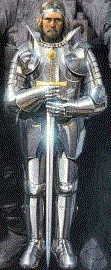
A romantic idea of what Arthur looked like - totally false.
5 years after the last update to this page I was
looking at a 'new' programme on tv about Arthur. If I summarise the
script as follows,
you can clear see that nothing has been proved, or
found, in the past 5 years.
"it is
thought ..............." "It has been suggested ........."
"Some people believe ............." "It is possible that .........."
in other
words - NOTHING!!
|

The main legend of King
Arthur has grown over many years as the result of poets and troubadours. This
stems mainly from 12th Century writers. They constructed and sang of these tales
which originated from the spoken word, passing through the years with inevitable
twists. King Arthur probably did exist (born about 465AD) but he was not as depicted. He
was said to be the son of Uther Pendragon and Ygraine of Cornwall. In early Latin
chronicles he is depicted as "Dux Bellorum" or Military Leader.
He never wore 'shining armour' this was a hangover from a book by Sir Thomas
Mallory and books written in the
middle ages and beyond in which he was 'modernised'.
He was a Celtic Clan or
Tribal Chief who united the country against Saxon invaders. Following
Roman rule, which brought with it law and order, the country descended into
anarchic chaos for many years. Fragmented and leaderless, the tribes or clans of
England frequently warred against each other. Being fragmented, the land could
offer little resistance to frequent invasions from abroad. The Saxons were being
driven from their European homeland by invading people from the east, the
Steppes of what is now Russia. The Steppes were becoming arid and the people
moved ever westward in search of more fruitful lands. The name Arthur,
back in those days, meant "Great Bear" or "Arth Fawr",
a name which could have been given to any chieftain. He was a man who forged a
cohesion among the British tribes, to face the threat from Anglo Saxons, who
spoke English. As throughout the ages, the problem was that of displaced
people, refugees. Each generation reinterprets the story of Arthur - in the
1970s the interest tended more towards the magical, mystical and ethereal.
Nowadays, we tend to approach these myths based on archaeology and historical
research, formed in flesh, blood, fur and metal.
(See footnote - Oct 2010, below).
|
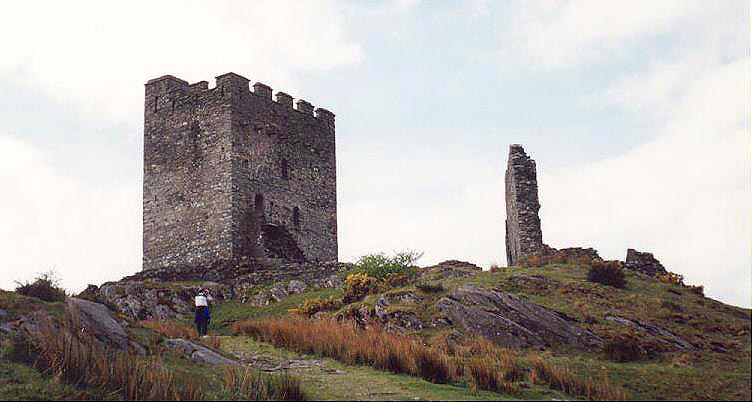
Caerleon Castle
|
His home or
"base" is also the subject of much debate and controversy. It has been
placed in Caerleon, South Wales and most famously in Tintagel, Cornwall although
the latter seems to be more unlikely.
(See
new footnote - Oct 2010, below).
The castle at Tintagel was built hundreds of
years after the alleged time of Arthur. Some say a local lord wanted to
'bask in the glory of the legend' so built a castle here, but it was all
for show and defensively a none starter. It was a whitewashed building
and, when entered, contained nothing. There has been found a settlement on
the headland side of the castle, much of which is still unexcavated but
probably housed hundreds. And graffiti on a 5th century slab which
(possibly conveniently?) contains the name Arto. Another legend says
Arthur was concieved here, but again, no proof. Tintagel itself was a
major 5th C port dealing in Mediterranean goods from Byzantium and coastal
areas in return for tin. But that was all, no kings, no glamour, just a
thriving seaport. The castle itself has been split in two by the erosion
and collapse of part of the headland into the sea, it was once, one.
Arthur is also associated with Glastonbury.
The Tor at Glastonbury rises high about the surrounding land, which in those
days, was probably well under water, or at least exceedingly marshy.
Indeed, this is the supposed location for the "lady of the lake".
Avalon is reputed to be here, where the mighty sword Excalibur was forged and
where Arthur's body was brought to rest. Arthur was also supposed to have made
his headquarters atop Cadbury Hill nearby. Also he is alleged to have rescued
his queen Guenevere from the clutches of the evil King Melwas here. All
these tales cannot be true or even close, otherwise Glastonbury would be many
things and places at once, all different and all shrouded in mystery. The most
famous of legends surrounding Glastonbury is the supposed landing nearby of
Joseph of Arimathea, with the holy grail. He "planted" his staff in
the hillside from which grew the famous Glastonbury Thorn, a tree indigenous to
the Middle East.
In 1190 monks "discovered" King Arthur's grave - this
was probably more to do with their self importance, increasing the importance of
the Abbey rather than any legitimate archaeological find. Furthermore monks
are supposed to have re-interred Arthur in Cadbury Hill. For the claims of
Caerleon (Which, in Welsh, means Fortress of the Legions) to this
"throne" of King Arthur visit the following web site: http://www.caerleon.net/history/arthur/.
Neither Tintagel, Caerleon nor Glastonbury are going to give up their
"rights" to Arthurian legend without a fight - who is wrong - who is
right is not up to me to decide.
I am not a historian, just a nosy Englishman
who likes a mystery! Arthur's association with Glastonbury is pure invention.
The destitute monks needed something to bring in the tourist. they
'invented' the legend of Arthur and Glastonbury to finance themselves,
nothing more. And he certainly was NOT buried there. There never was an Athurian grave at Glastonbury.
Just as they invented the story of the staff sprouting into a thorn tree.The science of geophyics can now be used
to penetrate the ground with radar and visualise the results. A supposed
grave in Shropshire turned out to be the site of a ancient furnace!! |
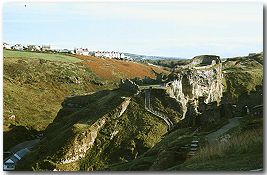
Tintagel Castle
|
The earliest full stories
concerning King Arthur and his exploits appear to be the little known Welsh
tales of "Culhwch and Olwen" and the "Dream of Rhonabwy".
Though dating from before the 11th century, these two stories became a late
attachment to a collection of Welsh mythological tales taken from the 14th
century White Book of Rhydderch and Red Book of Hergest. Together, they are
known as the "Mabinogion". The
Welsh monk Nennius first mentions Arthur around the year 830AD. Rather unsurprisingly he
refers to Arthur as a warrior - not a king. |

Mabinogion
|
The book known to the Welsh
as The Mabinogion is a collection of stories which evolved over 1,000 years. The
stories were passed from generation to generation by bards and story-tellers
from the 4th century onwards, but were not written down in a surviving
manuscript form until the 13th century. The White Book of Rhydderch (1325) and
the Red Book of Hergest (1400) between them contain 11 stories. The four tales
known as the Four Branches of the Mabinogi are set in an imaginary magical world
of early Celtic myth and two other tales tell of half-remembered history at the
time of the Roman occupation.
The much-maligned Geoffrey
of Monmouth, Archdeacon of Monmouth and later Bishop of St. Asaphs, first
popularized King Arthur's story, around 1139, in his story "History of the Kings
of Britain". Though he was writing some six hundred years after Arthur's
death, there is good reason to suppose that Geoffrey's history was "made
up...from an inordinate love of lying" as both contemporary and modern
historians almost universally insist. Geoffrey claimed he had taken most of his
information from an earlier British source, unknown to us today, but he admitted
it was a 'story'. From the time of Julius Caesar's
invasion of Britain in 55 bc, which both Geoffrey and the great man himself
relate at great length, we can be fairly sure that the Archdeacon is reciting
mere legend and imagination. Characters were added to the 'story' as time
progressed. And about as real as Monty Python's Holy Grail escapades.
|

|
It was the French medieval poet, Chrétien de Troyes,
however who, not long after Geoffrey, introduced us to most of the characters
and tales that we now think of as an integral part of the Arthurian story. He
'specialized' in tales of Arthurian courtly love and thus brought us: Erec &
Enid (1160), Lancelot (c.1162), Cligés (1164), Yvain (c.1170) and the Count of
the Grail (also known as Perceval) (1180). He transformed the names of
Geoffrey's characters from Welsh to the medieval French used today. It was Chrétien
and those who followed him who helped to distort the Arthurian story, so that the true
historical Arthur became lost in an amalgam of Celtic myth and massive literary fantasy.
For example, neither Lancelot nor the Holy Grail were part of the Arthurian
legend before Chrétien came along. Both do have origins in early Celtic myth,
but there is little justification for including them in Arthur's story. |
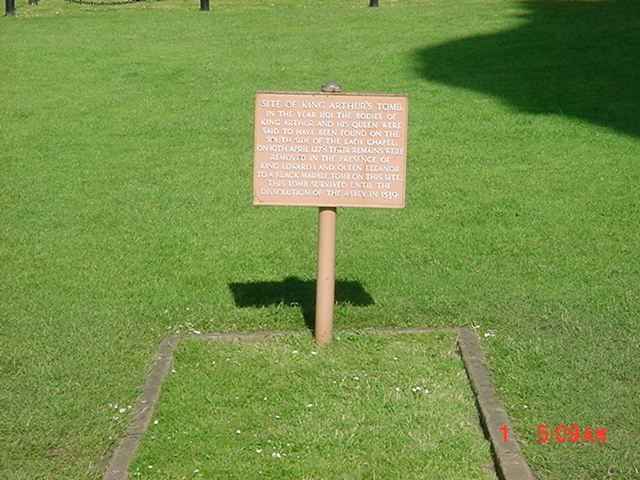
The incorrect resting place of King Arthur and his
Queen in Glastonbury Abbey (mike kemble (c) 010602)
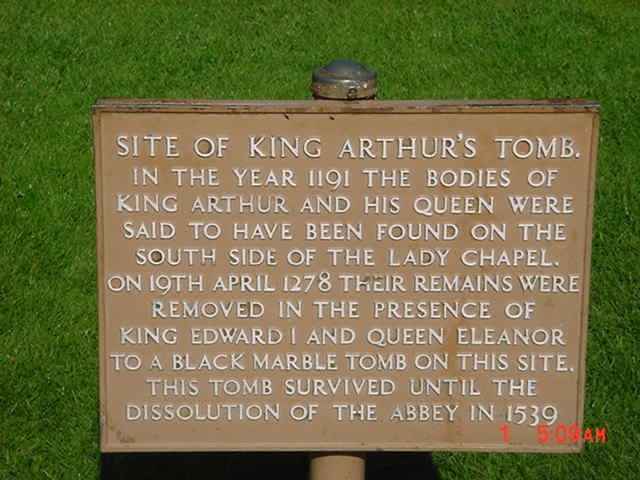
And the plate in greater detail (c) mike kemble
010602
|
During the early 13th century, the anonymous Vulgate
Cycle further embellished the Arthurian stories. This collection of romantic
prose was apparently put together by Cistercian clerics between 1215 and 1235,
some say at the instigation of their founder, St. Bernard of Clairvaux. The vast
work consists of the Prose Lancelot, Queste del Sainte Graal, Estoire del Sainte
Graal, Mort Artu and Vulgate Merlin. It is particularly noted for introducing
the idea that Mordred was the incestuous son of King Arthur.
Sir
Thomas Malory's 15th century work, "Le Morte d'Arthur" is,
perhaps, better known than Geoffrey or Chrétien. He took their stories and
retold them with an epic unity, creating the 'Romantic Age of Chivalry'. With one
stroke of his pen, he transformed Arthur's Court from Dark Age obscurity to the
height of medieval pageantry. Being written in English and printed by Caxton,
"Le Morte d'Arthur" was instantly available to the masses, and it
remains highly popular, even today, as a classic work of literature. Malory's
work, however, is just that, a work of pure fictitious literature. There is little history left
amongst his pages. I suppose we could refer to him as the Jack Higgins or David
Eddings of his day - pure fiction! This gentleman is probably the main reason we
think of Arthur in the chivalrous, shining knights theme of today! Also just as guilty is Lord Tennyson
and such romantic victorian fiction writers.
Arthur's modern popularity owes much to his re-emergence
during the Victorian Age at the hands of Alfred, Lord Tennyson. His huge poetic
elegy entitled "Idylls of the King" led to a resurgence in interest in
this early monarch, as reflected in much of the pre-Raphælite art of the time.
The fascination is still going strong today. However, modern Arthurian students
have become much more critical of the romantic picture woven by many of these
literary greats. Nowadays, we tend to be much more interested in the real
Arthur, drawing upon the Mabinogion, Geoffrey and beyond, to examine historical
sources that may just show us a glimpse of the truth behind this strangely
compelling character.
|
October 2010 Footnote:
I recently watched a tv programme
on the legend of Arthur and they have proved to a certain extent that this man actually did exist.
Not only that but was a Welsh chieftain who united tribes against the Saxon
invaders when, before, only disunited tribes tried, unsuccessfully, to stem the
Saxon march across England from the east coast. It is almost certain that his
base was in fact CHESTER, where he used the remains of the Roman town
as a base for raids against the Saxons. There are recorded 10 battles that
Arthur mounted against these invaders, the most northerly being across the
border just north of Hadrian's Wall.
The confusion seemingly lay with Arthur's medieval
chronicler, Geoffrey of Monmouth, whose patron, Robert of Gloucester, was Lord
of the Monmouth Marches, where Caerleon-on-Usk is situated. It seems that
Geoffrey, doubtless partly in order to please his Lord, attributed all
references dealing with 'Caerleon-ar-Dour' (Chester) to Caerleon without
qualifying which one the old chronicles were referring to. As a consequence,
historians have ever since been crediting Caerleon as being Arthur's seat. Lets
not forget either that Chester was a major northern seaport until the
disasterous silting up of the River Dee in later centuries. Chester was Deva to
the Roman Legions but Chester was not its name before; that came much later. Was
it Caerleon in truth?
There is also evidence of a battle in
Chester itself. Known as the city of the Legions, Chester sported, pardon the
pun, a massive colluseum which was rivalled in size only by Rome itself. This
colluseum was transformed into an armed fortress by Arthur, evidence in excavations
show us that he reinforced the structure, built massive towers of wood and
sealed off the surrounding doorways. Arthur was Christian and there is evidence
that he purposely chose the colluseum as his base because, found in the centre
of the excavations was a roman tether stone, a large block with an iron ring set
in it which had, amongst others, Christians, chained to it so they could not
escape their fate.
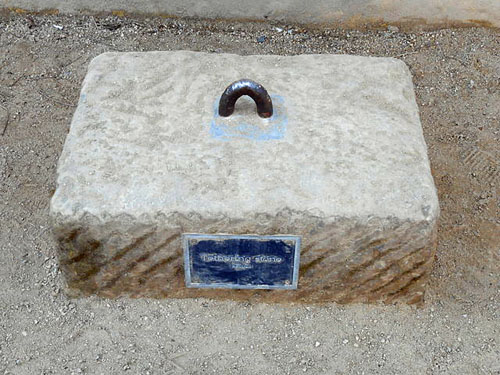
replica tethering stone - Chester
There is also evidence that someone, possibly Arthur himself,
built a wooden shrine over this stone and created a place of worship for the
souls of the Christians who died, tied to this stone. The stone has been removed
from the excavations amidst some degree of superstition and foreboding.
Estimates put the seating capacity of the two-floor amphitheatre at between
8-10,000 spectators, suggesting the town could have had a substantial civilian
population. There is also documentary evidence that Chester lay deserted from
the Roman evacuation to the time Arthur took up court in Chester.
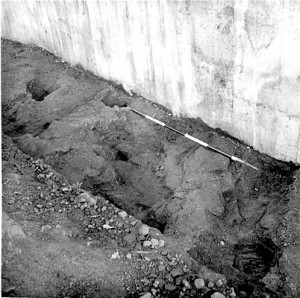
Arthurian Postholes



|
Merlin was almost certainly a purely fictitious character.
Once again Geoffrey of Monmouth seems to be to blame. However, it is nice to
think that such a mystical character could have existed in those times; it is,
however, highly unlikely and is probably based upon some ancient tales of wild
men living in woods handed down through the ages. Britain was mostly
woodland then anyway - thus there may have been a lot of "wild
men" to go round! I believe that Merlin was about as "real" as
Gandalf the Grey, another fictitious mystic of more modern literature.
Geoffrey's modern day equivalent would surely have written scripts for such
rubbish as "Dallas"!! |

|
Merlin first appears in records (Armes Prydein, Y Gododdin) from the early 10th century as a mere prophet, but his role
gradually evolved into that of magician, prophet and advisor, active in all
phases of the administration of King
Arthur's kingdom. He was apparently given the name Emrys (or Ambrosius) at
his birth in Caer-Fyrddin (Carmarthen). He only later became known as Merlin, a
Latinized version of the Welsh word, Myrddin, taken from the place of his birth.
Geoffrey of Monmouth
is thought to have invented this form (as he did so much else), since he did not
want his character to be associated with the French word, merde, meaning
"excrement". But his version of history is merde!
Merlin was the illegitimate son of a monastic Royal
Princess of Dyfed. The lady's father, however, King Meurig ap Maredydd ap Rhain,
is not found in the traditional pedigrees of this kingdom and was probably a
sub-King of the region bordering on Ceredigion. Merlin's father, it is said, was
an angel who had visited the Royal nun and left her with child. (Oh
the excuses they came up with in those days?). Isn't
it strange that Arthur was also born of the use of sorcery too when Pendragon
'shape shifted' to seduce Arthurs mother. Merlin's enemies claimed
his father was really an incubus, an evil spirit that has intercourse with
sleeping women. The evil child was supposed to provide a counterweight to the
good influence of Jesus Christ on earth. Merlin, fortunately, was baptized early
on in his life, an event which is said to have negated the evil in his nature,
but left his powers intact. The original story was presumably invented to save
his mother from the scandal which would have occurred had her liaison with one
Morfyn Frych (the Freckled), a minor Prince of the House of Coel, been made
public knowledge (See what I mean?).
|

|
Legend then tells us that after the Roman withdrawal from
Britain and the usurpation of the throne from the rightful heirs, Vortigern
was in flight from the Saxon breakout and went to Snowdonia, in Wales, in hopes
of constructing a mountain fortress at Dinas Emrys where he might be safe.
Unfortunately, the building kept collapsing and Vortigern's house wizards told
him that a human sacrifice of a fatherless child would solve the problem. One
small difficulty was that such children are rather hard to find. (Especially
if they are going to be sacrificed!) Fortunately for Vortigern's
fortress, Merlin was known to have no human father and happened to be available.
Before the sacrifice could take place, Merlin used his
great visionary powers and attributed the structural problem to a subterranean
pool in which lived a red and a white dragon. The meaning of this, according to
Merlin, was that the red dragon represented the Britons, and the white dragon,
the Saxons. The dragons fought, with the white dragon having the best of it, at
first, but then the red dragon drove the white one back. The meaning was clear.
Merlin prophesied that Vortigern would be slain and followed on the throne by Ambrosius
Aurelianus, then Uther, then a greater leader, Arthur. It would fall to him
to push the Saxons back.
True to the prophecy, Vortigern was slain and Ambrosius
took the throne. Later, Merlin appears to have inherited his grandfather's
little kingdom, but abandoned his lands in favour of the more mysterious life
for which he has become so well known. After 460 British nobles were (allegedly)
massacred at a peace conference, as a result of Saxon trickery, Ambrosius
consulted Merlin about erecting a suitable memorial to them. Merlin, along with
Uther, led an expedition to Ireland to procure the stones of the Chorea
Gigantum, the Giant's Ring. Merlin, by the use of his extraordinary powers,
brought the stones back to a site, just west of Amesbury, and re-erected them
around the mass grave of the British nobles. We now call this place Stonehenge.
We know Stonehenge to be much older than the supposed time scale of this tale. (Geoffrey
of Monmouth, of course, did not!)
|

|
After his death, Ambrosius was succeeded by his brother,
Uther, who, during his pursuit of Gorlois
and his irresistable wife, Ygerna
(Igraine or Eigr in some texts), back to their lands in Cornwall, was aided by
Merlin. As a result of a deception made possible by Merlin's powers, Uther was
transformed into the image of Gorlois. He entered their castle, managed to fool
Ygraine into thinking he was her husband, had his way with her and in the
course of things, conceived a child, Arthur. Poor Gorlois, not knowing what was
going on, went out to meet Uther in combat, but instead, was slain by Uther's
troops.
After Arthur's birth, Merlin became the young boy's tutor,
while he grew up with his foster-father, Sir Ector (alias Cynyr Ceinfarfog (the
Fair Bearded)). There is a tale of Merlin escaping with the child into the
wilderness, if so where does it tell us of the hue and cry, a missing prince??
He just 'walks off into the sunset with a kidnapped child' - come on!! In the defining moment of Arthur's career, Merlin arranged for
the sword-in-the-stone contest by which the lad became king. Later, the magician
met the mystic Lady
of the Lake at the Fountain of Barenton (in Brittany) and persuaded her to
present the King with the magical sword, Excalibur. In the romances, Merlin is
the creator of the Round Table, and is closely involved in aiding and directing
the events of the king and kingdom of Camelot. He is pictured by Geoffrey of
Monmouth, at the end of Arthur's life, accompanying the wounded Arthur to the
Isle of Avalon for the healing of his wounds. Others tell how having fallen
deeply in love with the Lady of the Lake, he agreed to teach her all his
mystical powers. She became so powerful that her magical skills outshone even
Merlin's. Determined not to be enslaved by him, she imprisoned the old man in a
glass tower, a cave or similarly suitable prison. Thus his absence from the
Battle of Camlann was ultimately responsible for Arthur's demise.
According to Geoffrey's "Vita Merlini" (c. 1151),
Merlin/Myrddin was a sixth century prophet living in the north of Britain where
his career extended beyond Arthur. Merlin travelled north, after Camlann, to the
court of King Gwendoleu of Caer-Guenoleu (north of the Salway) where the locals
called him Lailoken (or Llallogan). Shortly afterward, a war broke out between
Merlin's Royal master and the three allies, King Riderch Hael (the Generous) of
Strathclyde and Kings Peredyr & Gwrgi of Ebrauc (York). Gwendoleu was killed
in the ensuing Battle of Ardderyd (Arthuret) and Merlin, sent mad with grief at
the death of his nephew and four brothers, fled into the Caledonian Forest. He
lived there in a mad frenzy for over a year, becoming known as Myrddin Wylt (the
Wild), before Riderch, who was his brother-in-law, found him and brought him to
safety in the Strathclyde Court.
|

|
Some scholars believe there were two Merlins: Myrddin Emrys
and Myrddin Wylt. The fact that Merlin apparently lived from the reign of
Vortigern (c.420) to the reign of Riderch Hael (c.580) would certainly support
this view. The stretch from Vortigern to Arthur is itself unlikely and early
versions of the "Vortigern at Dinas Emrys" story give the fatherless
boy as Emrys Wledig (Ambrosius Aurelianus) who was living in Campus Elleti in
Glywysing. Despite Myrddin Wylt's story indicating he may have had a conceptual
origin in one of the wild-man-in-the-woods motifs common to the ancient folklore
of the British Isles, this man's historicity is quite well established. His real
name, however, may have been Lailoken. Was this man misplaced in time, by
Geoffrey of Monmouth, to become King Arthur's mentor, some memory of a similar
character from Caer-Fyrddin giving rise to his new name? PC Bartrum thinks not
and points out that "fundamentally there is only one Merlin/Myrddin, and
some of the later legends cannot be consistently classified as appropriate to
one rather than the other."
His prison and/or burial place is said to be beneath
Merlin's Mound at Marlborough College in Marlborough (Wiltshire), at Drumelzier
in Tweeddale (Scotland), Bryn Myrddin (Merlin's Hill) near Carmarthen (Wales),
Le Tombeau de Merlin (Merlin's Tomb) near Paimpont (Brittany) and Ynys Enlli (Bardsey
Island) (Also thought of as another "Avalon") off the Lleyn Peninsula
(Wales). They must have dissected his body first!
|

|

